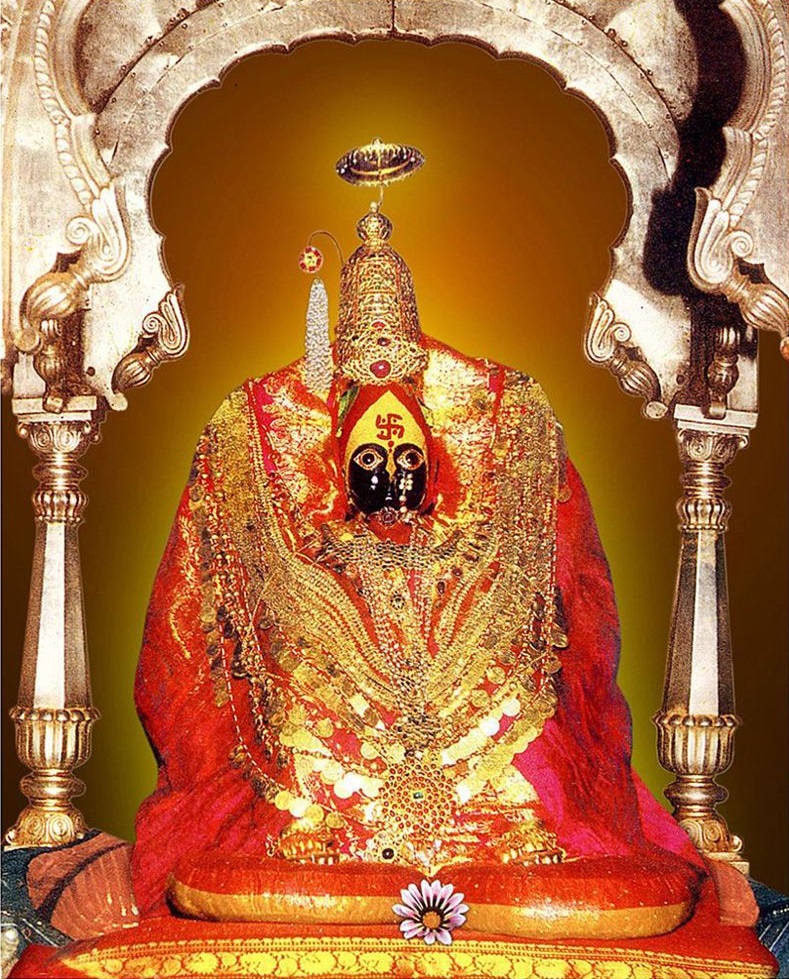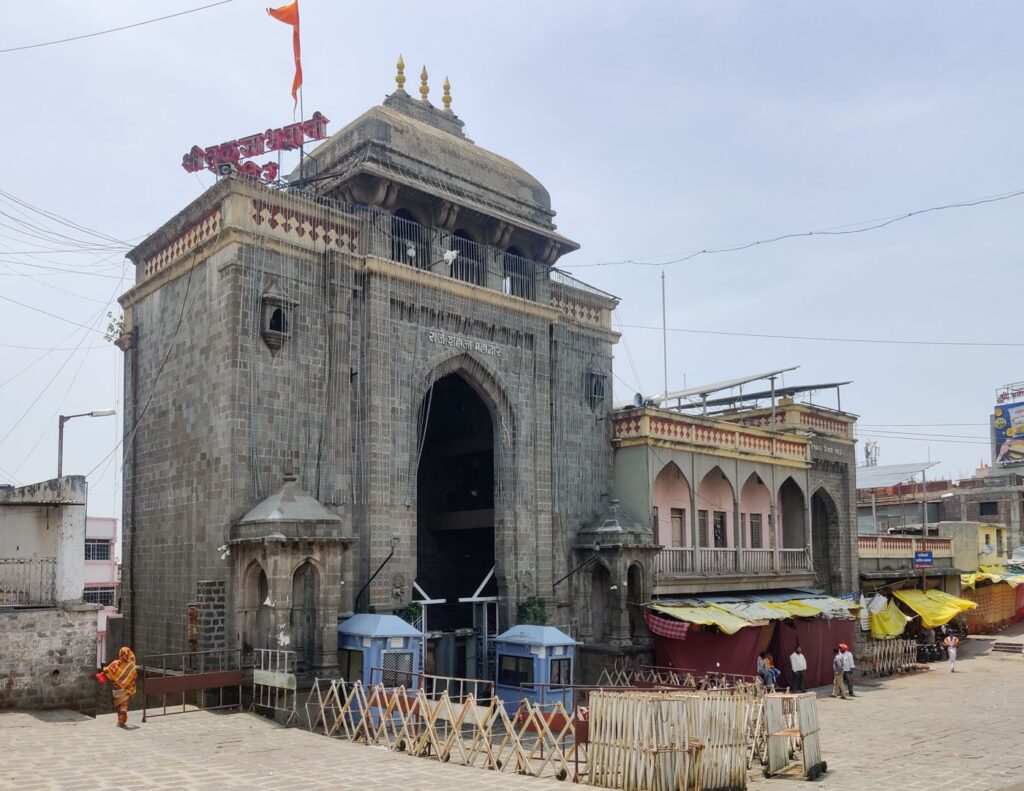
Tulja Bhavani temple is a Shakti Peetha devoted to Tulja Bhavani Devi who is the Kula Devi i.e. family deity for many people in Maharashtra and other states of India especially the royals. It is located in Tuljapur town of Osmanabad district in Maharashtra (India).
Tulja Bhavani Devi’s influence has been strong in Indian Culture so much so that this influence traveled all the way to different parts of Indian Subcontinents. In Nepal, Tulja Bhavani is regarded as Taleju Devi who is guarding Deity of Newari community. The worship of Taleju in Nepal is quite prominent.
The temple is part of the famous three and a half Shakti Peethas in Maharashtra which includes the Mahalakshmi Temple in Kolhapur, Renuka Temple in Mahur and Vani Saptashrungi Temple. It is said that the great Maratha King and warrior Chhatrapati Shivaji Rao had obtained his sword from Tulja Bhavani Devi. He hails from the Bhonsla dynasty which worships Tulja Bhavani Devi as their Kula Devi i.e. family deity.
Tulja Bhavani Devi is also known by the names Tulaja, Turaja, and Twarita. The worship of the Deity is done by the Kadamb Bhope family. The temple was built in the 12th century by the Maratha Mahamandaleshwara Maradadeva Kadamb.
Origin of Tulja Bhavani Temple
In the Satya-yuga, lived a Sage by the name Kardabh along with his beautiful and chaste wife Anubhuti. They were blessed with a son too. But the happiness was not long-lived. Sage Kardabh left his body leaving behind his wife and son.
Anubhuti decided to end her life too leaving the child to the care of Bhavani Devi. But quoting from the scriptures, a few Sages told her that she does not have to end her life as she had a child. Listening to the advice of the Sages, Anubhuti decided to desist from taking her life. Rather, she went to the banks of the sacred Mandakini river near the Meru mountain and started performing austerities after building an ashram.
While engaged in austerities, a demon by the name Kukur became enamoured by the beauty of Anubhuti. The demon became lusty for Anubhuti and hence, touched her. When Anubhuti’s austerities were broken by the touch of the demon Kukur, she immediately got up and ran to get the help of Bhavani Devi whom she called out loudly.
Hearing the cries of her dear devotee, Bhavani Devi came running to protect Anubhuti. Bhavani Devi challenged the demon who changed his form into a buffalo and started fighting with her. As they fought, Bhavani Devi killed Kukur using her celebrated Trident.
Thus, Anubhuti was extricated from the harassment of the demon Kukur. From then onwards, the Goddess came to be known as Tulja Bhavani Devi.
Deities of Tulja Bhavani Temple
The Deity of Bhavani Devi in Tulja Bhavani Temple is very enchanting. She flanks eight arms. Her left shoulder beholds the sun while her right shoulder beholds the moon. In one of her right palms, she holds her main weapon ‘Trishul’ while she stamps the beheaded body of demon Kukur with her right foot.

Her left foot is straight on the ground. The head of the demon lies between her legs. This deity is moveable unlike other deities which are usually fixed. It was consecrated by Sri Adi Shankaracharya along with a Sri Yantra.
After crossing the Sabhamandapa, to the east is the deity of Bhavani Shankara, a swayambhu linga, Nandi, etc. In the temple premises are the deities of Lord Narasimha, Khandoba, Chintamani and other devatas.
Adimaya and Adishakti deities stand on the right side of the temple entrance. There are shrines for Sri Siddhi Vinayaka on left side of the main gate, Matangi Devi, Sri Dattatreya, Annapurna Devi and Sri Vitthal Rukmini in the temple complex.
Tirthas of Tulja Bhavani Temple
Within the temple complex lies the Kallola Tirtha which contains the waters of the sacred rivers like Ganga, Yamuna and Saraswati along with the sacred waters of the mountain ranges like the Himalayas, Vindhyas, Malay and Trikuta. On the request on Lord Brahma, all these sacred waters poured into the tank like torrents causing a huge Kolahala. Thus, this tirtha got its name by shortening ‘Kolahala’ to Kallol.
The Gomukh Tirtha in the temple complex is sacred too. The water in this tirtha is said to be non-different from that of the Ganga. Water falls into the Tirtha from the mouth of a cow, which is a six-feet high stone structure.
Locally, it is said that a mahant by the name Garibnath could not believe that the water in the Gomukh Tirtha was non-different from the actual Gomukh in the Himalayas. Bhavani Devi infused belief in him through a miracle in which a lemon and stick thrown by the mahant in the Ganges at Kashi fell into the Gomukh Tirtha in Tuljapur.
Architecture of Tulja Bhavani Temple
This 12th century Tulja Bhavani Temple greets you with a Mahadwar, which is really very big, fascinating and made from carved stone blocks. There are two main east-facing entrances i.e. Raja Shahaji Mahadwar and Rajmata Jijau main gate. Passing through the Sardar Nimbalkar Pravesh Dwar after the main entrance, there is a temple of Markandeya Rishi on the right.

Inside the Tulja Bhavani Temple complex is the Kallol Tirtha on the left and the Gomukh Tirtha on the right after you alight from the stairs.
The temple structure consists of the Gabhara i.e. sanctum, Garuda Mandapa and Sabhamandapa. Sixteen partially turned and partially sculpted pillars make up the Sabhamandapa. It presents a mix of local and South Indian architecture. The courtyard is surrounded by cloisters.
To the north of the Gabhara is Tulja Devi’s sleeping room with a silver bed in it. Many deities have been placed on the western entrance of the temple.
Protective walls enclose the temple complex. These were built centuries ago to protect the temple from the invading Islamic kings. Various animals, birds, trees, devatas and celestial beings have been carved on the temple structure.
Though not huge, the Shikhara of Tulja Bhavani Temple has been built in the local Peshwai style architecture with the Kalasha, Amalaka, creepers, the niche and chhatri motifs. It is supposed to be of 18/19th century origin. A look at the Shikhara externally will give you joy due to its colourful nature.
Important Mutts connected to Tulja Bhavani Temple
There are four important mutts connected to Tulja Bhavani temple. They are as follows –
Bharati Buva Mutt: This Mutt has a long tradition and following. Tulja Bhavani Devi used to visit Bharati Buva Baba at night to play a game of dice with him. Therefore, it become customary to call back the Goddess to the Gabhara before the commencement of the morning pujas. This practise continues to this day.
Sant Garibnath Mutt: Also known as the Dashavatar Mutt, they are long connected with the Gomukh Tirtha in the temple. The chief of the Mutt can visit the temple only once a year.
Bakoji Baba Mutt: This Mutt guards the temple premises.
Hamroji Baba Mutt: This Mutt protects the ornaments of the Goddess. A representative of the Mutt must be present when the ornaments are received or handed over by the treasury.
Festivals of Tulja Bhavani Temple
Navaratri is the main festival of Tulja Bhavani temple. Devotees throng the temple on this occasion performing special pujas and prayers. Some people fulfil vows to the Deity by performing Gondhal or dance, performing dandavats at every step from their house to the temple, Panchamrut snana, offering sarees to Devi, putting Kumkum in the courtyard for longevity of husbands, etc.
A special ritual is done on the Vijayadashami day by the Teli community using bamboo from Solapur, beds from Bhingar and Palki from Nagar.
Some of the other festivals observed in the temple are Shakambari Navaratri (Dec – Jan), Makara Sankranthi, Ratha Saptami, Gudi Padwa, Shitala Shashti and Lalita Panchami.
Every Tuesday is akin to a small festival with a procession or Chabbina of Tulja Bhavani Devi taken out in a wooden vahana like hamsa, simha, peacock, Garuda, etc. Musicians from specific communities play musical instruments like the sambal. The martial traditions of the Maratha community are narrated by the Gondhali communities along with the lilas of Tulja Bhavani Devi.
Temple Timings of Tulja Bhavani temple
Tulja Bhavani temple is open from 4 AM in the morning to 10 PM in the evening. There could be slight changes in timings on festivals and special occasions.
Important pujas done throughout the day –
Charan Tirtha Kakada Aarti: 04.30 AM
Morning Abhishekam Pooja: 6 AM to 10 AM
Vastralankar Pooja Aarti and Dhuparati: 11 AM
Evening Abhishekam Pooja: 7 PM to 9 PM
Vastralankar Pooja Aarti & Dhuparati, Prakshal Pooja: 09.30 PM
How to Reach Tulja Bhavani Temple
To visit Tulja Bhavani Temple – an important Shakti Peetha which ranks second in the list, the Pandharpur Nashik Yatra by Tirtha Yatra is recommended if you intend to get the best experience.
Tuljapur is well-connected to various cities/towns all over India apart from cities/towns in Maharashtra via state and national highways. You can choose your travel mode based on the options available below –
By Road: There are enough state and private bus services to Tuljapur from various parts of Maharashtra and other states. You can book a taxi to Tuljapur provided you’re fine with the charges. You’ll enjoy your ride if you’re driving down yourself.
By Rail: Solapur Railway Station 47 km away and Osmanabad Railway Station 30 km away are the nearest rail points to Tuljapur. You’ll find more trains from all over India at Solapur Railway Station. After alighting here, you can take an autorickshaw or bus to the temple.
By Air: Aurangabad Airport 259 km away and Pune Airport 294 km away are the nearest operational airports. You can fly in here and reach the temple via the rail or road route.
Best time to visit Tulja Bhavani Temple
Although the temple welcomes everyone and is crowded throughout the year, it is better to visit during the time of Ganesha Chaturdashi to have peaceful darshan of Bhavani Devi.
October to March is an ideal time to visit Tulja Bhavani Temple.
Tulja Bhavani Devi: The Bhakta Vatsala
Tulja Bhavani Devi is undoubtedly the protector of her devotees. Be it Anubhuti or Chhatrapati Shivaji Maharaja, Bhavani Devi appeared on the scene to protect them. It is said that Bhavani Devi had even appeared on the hill nearby in the Treta Yuga to show Lord Rama the route to Lanka while He was searching for Sita Devi.
There are many other lilas of the Devi too. This shows her mamata or motherly affection for her children. In your hour of need, you too can call out to Bhavani Devi. She will undoubtedly answer your sincere prayers. Jay Tulja Bhavani!
3










3 Comments On Tulja Bhavani Temple, Tuljapur
Shamala Devi
Request more information on ” Kandoba”, Deity, as we worship this deity during important occasions like marriage, house warming and Upanayana in our family. We don’t have any information about this deity. It would be very helpful for us.
Thank you for the enquiry. We shall surely research and publish an article about this.
Mahesh B Naik
This is my family diety I go every year without fail, Jai Tulja Bhavani